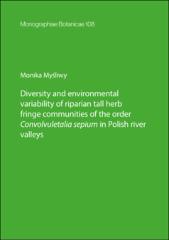Repozytorium Polskiego Towarzystwa Botanicznego
Diversity and environmental variability of riparian tall herb fringe communities of the order Convolvuletalia sepium in Polish river valleys
JavaScript is disabled for your browser. Some features of this site may not work without it.
| dc.contributor.author | Myśliwy, Monika | |
| dc.date.accessioned | 2020-01-01T17:29:28Z | |
| dc.date.available | 2020-01-01T17:29:28Z | |
| dc.date.issued | 2019 | |
| dc.identifier.citation | Myśliwy M. Diversity and environmental variability of riparian tall herb fringe communities of the order Convolvuletalia sepium in Polish river valleys. Wrocław: Polish Botanical Society; 2019. (Monographiae Botanicae; vol 108). https://doi.org/10.5586/mb.2019.001 | |
| dc.identifier.isbn | 978-83-954123-2-5 | |
| dc.identifier.issn | 2392-2923 | |
| dc.identifier.uri | https://hdl.handle.net/20.500.12333/265 | |
| dc.description.abstract | The riparian tall herb fringe communities of the order Convolvuletalia sepium represent an integral part of the natural vegetation in river valleys. The major objective of this study was to assess the relationships between the diversity and variability of these communities and various environmental factors. The survey was conducted in northwestern Poland, along 101 randomly selected 1–2-km long sections of 24 rivers and the Szczecin Lagoon. Samples were collected in 2008–2013 in all types of tall herb fringe vegetation found in the surveyed river sections. Data collected included hydrogeomorphic variables, soil parameters, potential and actual vegetation, and dominant land use form. A total of 24 vegetation units were documented, based on 300 sample plots (relevés). Tall herb fringe communities occurring in valleys of large rivers (Senecionetum fluviatilis, Fallopio-Cucubaletum bacciferi, Achilleo salicifoliae-Cuscutetum lupuliformis, Convolvulo sepium-Cuscutetum europaeae typicum and chaerophylletosum bulbosi subass. nov., Rubus caesius community, Solidago gigantea community) exhibited floristic and ecological differences in comparison with plant communities from small rivers (Eupatorietum cannabini typicum, aegopodietosum and cardaminetosum amarae subass. nov., Epilobio hirsuti-Convolvuletum sepium, Soncho palustris-Archangelicetum litoralis, Convolvulo sepium-Cuscutetum europaeae aegopodietosum, Urtico-Convolvuletum sepium typicum and aegopodietosum, Urtica dioica community, Galeopsis speciosa community, Rubus idaeus community). This finding fully justified their division into two alliances: the Senecionion fluviatilis and the Archangelicion litoralis, respectively. Significant differences between the tall herb fringe communities associated with large rivers and the plant communities occurring along small rivers included plant species richness, moss layer cover, contribution of river corridor plants, level of invasion, influence of adjacent plant communities on the floristic composition, relative elevation and distance away from the riverbed, degree of shading, proportions of all grain size fractions, soil pH, contents of organic matter, humus, organic carbon, total nitrogen, bioavailable phosphorus, potassium, magnesium, and calcium in the soil. The differences in environmental characteristics of individual plant communities were significant as well; they showed that most vegetation units were well defined. The variables that best discriminated between riparian tall herb fringe communities included the natural potential vegetation unit Salici-Populetum, headwater seeps, soil pH, sample elevation above the river water level, river size, flooding, degree of shading, soil moisture, K2O and CaO contents, and C/N ratio. The integration of the main riparian gradients (longitudinal, lateral, vertical) and patch perspective (e.g., natural potential vegetation units, and land use forms) significantly improved the comprehensive riparian vegetation patterns, because these two perspectives underpin different processes shaping the vegetation. This study contributed significantly to the knowledge of riparian tall herb fringe communities. Two subassociations are described here for the first time, whereas six others have not been previously reported from Poland. The data summarized in the synoptic table indicated that the species diagnostic for individual plant communities should be revised at the supra-regional scale. Some syntaxonomic issues were also determined. The inclusion of the order Convolvuletalia sepium to the class Epilobietea angustifolii resolved the problem of classifying the community dominated by Eupatorium cannabinum, a species showing two ecological optima: one in riparian tall herb communities and the other in natural gaps of the tree stands and clearings of fertile alder carrs and riparian woodlands. This also resolved the problem of classifying the communities dominated by Galeopsis speciosa and Rubus idaeus, intermediate between riparian tall herb and clearing communities. The results of this study may serve as a reference for management of the vegetation in river valleys and promote their conservation. They may also be essential for any future syntaxonomic revision of riparian tall herb fringe communities at a larger geographical extent. | en |
| dc.description.sponsorship | The research was supported by grants awarded by the Ministry of Science and Higher Education of the Republic of Poland and the National Science Center in Poland (grants Nos. N N305 231935 and N N305 018940), as well as by statutory funds of the Faculty of Biology, University of Szczecin. | en |
| dc.language.iso | en | |
| dc.publisher | Polskie Towarzystwo Botaniczne | pl |
| dc.publisher | Polish Botanical Society | en |
| dc.relation.ispartofseries | Monographiae Botanicae; vol. 108 | |
| dc.rights | Attribution 4.0 International | en |
| dc.rights.uri | http://creativecommons.org/licenses/by/4.0/ | |
| dc.subject | rivers | en |
| dc.subject | riparian vegetation | en |
| dc.subject | Senecionion fluviatilis | en |
| dc.subject | Archangelicion litoralis | en |
| dc.subject | environmental conditions | en |
| dc.subject | ordination | en |
| dc.subject | alien plants | en |
| dc.subject | level of invasion | en |
| dc.title | Diversity and environmental variability of riparian tall herb fringe communities of the order Convolvuletalia sepium in Polish river valleys | en |
| dc.type | Book | en |
| dc.identifier.doi | 10.5586/mb.2019.001 |
Pliki tej pozycji
Z tą pozycją powiązane są następujące pliki licencyjne:

